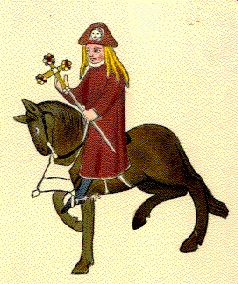

Leading into the Pardoner’s Prologue a remarkable moment occurs where we gain an insight to his travelling companion’s impressions of the Pardoner. The Pardoner of the Prologue to the Pardoner’s Tale



By exploiting his congregants' desires to find salvation and lead good lives, he cynically sells them fake reliquaries as good luck charms and miracle cures and in doing so he bastardizes the Christian doctrine he preaches into a lucrative money making operation. He is depicted as smooth, delicate, lady-like and honey-tongued, duplicitous in his supposedly holy dealings, extremely rich from his deceitful profession and as a man whose very being is totally incongruous with his career as a servant of the Church. The Pardoner leads a sinister life and is consumed with cupiditas. Outwardly praiseworthy, but ultimately censorious, the irony which is thick on the page as the admiring tone describing the clergyman’s gentleness, fashionable mode, delightful singing and unequalled grace is a thin veneer which does not conceal the writer’s obvious distain for The Pardoner. Chaucer brings his audience’s immediate attention to the Pardoner’s preternatural sexuality to draw on the powerful association in the medieval mind between homosexuality and wickedness, immorality, licentiousness and even heresy. The Pardoner is thoroughly emasculated and given characteristics of sexual abnormality to draw parallels between his physical and sexual deviancy and his spiritual and moral perversions. Finally, his bare chin which ‘no beard had harboured, nor would harbour, smoother than ever chin was left by barber’ were believed to denote great cleverness and ingenuity and gives an overall portrait of a man who is ‘an abandoned rascal delighting in hypocrisy and possessed of a colossal impudence’. Physiognomic interpretation also gives the reader to understand that his ‘bulging eye-balls, like a hare’ were signs of pride, impudence, shamelessness and lack of propriety. Additionally, Chaucer as the narrator judges him to be ‘gelding, or a mare’, an allusion to the possibility the Pardoner may be a eunuchus ex nativitate (a natural eunuch due to congenital defect). This sentiment is further reinforced through the description of his having a high pitched ‘small voice a goat has got’ which is another physiognomic trait denoting effeminateness, and evoking the probability of homosexuality. The Pardoner’s ‘hair as yellow as wax, hanging down smoothly like a hank of flax,’ confers the clergyman’s probable impotence and lack of manhood. By appropriating these contemporarily familiar precepts, Chaucer outlines the Pardoner’s features, physique and deportment to produce a recognizable character type for his audience. Physiognomy was the well known art of judging and interpreting human character and personality based on a study of the facial features. Our initial introduction to the Pardoner as a ‘noble ecclesiast’ in the General Prologue sees him described in a manner that refers frequently to the ancient practice of physiognomy. From his iconic introduction in the General Prologue to the brazen mountebank who declares himself a charlatan yet still attempts to peddle his quack medicines and false relics at the end of his tale, the Pardoner gives readers of ‘The Canterbury Tales’ a thoroughly detestable and corrupt character to grapple with. The Pardoner depicted by Geoffrey Chaucer (1342-1400) in his frame narrative, ‘The Canterbury Tales,’ reflects contemporary opinion of the church sanctioned profession of salvation salesman and is arguably the most contradictory and contentious of Chaucer’s pilgrims. Eventually plenary indulgences required purchasers neither to repent, nor to amend their lives in order to receive complete absolution from sin, causing pardoners to become scrutinized in life and satirized in popular literature. Pardoners were known to exaggerate the efficacy of their indulgences and claimed the authority to promise deliverance not just from purgatory, but from hell itself. Not surprisingly where salvation was available for purchase, the Christian doctrine of repentance and forgiveness inevitably grew corrupt. A pardoner was an unordained medieval cleric who raised money for the church by the selling of papal indulgences which offered the purchaser redemption from their sins and reduced periods of purgatorial punishment.


 0 kommentar(er)
0 kommentar(er)
